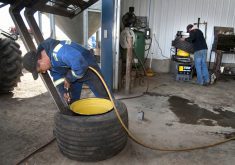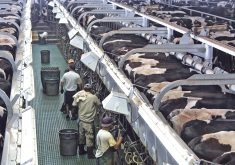For Alberta farmers and ranchers, there are no off hours. Every season brings its challenges and some seasons require extra hands to get all the work done.
It’s a way of life that’s never going to change, but changes to Alberta’s Employment Standards mean farmers and ranchers are going to have to take steps to ensure they’re following the law when it comes to waged, non-family employees.
In June 2017, the province passed the Fair and Family-Friendly Workplaces Act, which includes specific changes to the Employment Standards Code to apply it to ranches and farms. As of Jan. 1, the new rules apply to farms and ranches with waged, non-family workers. This includes year-round and seasonal employees.
Read Also

Proactive approach best bet with looming catastrophes
The Pan-Canadian Action Plan on African swine fever has been developed to avoid the worst case scenario — a total loss ofmarket access.
The employment standards do not apply if everyone who is paid a wage to work on your farm or ranch is an owner or a family member of an owner. Nor do they apply if all non-family members are just helping out or participating in activities like 4-H.
What’s changed and what it means
Before Jan. 1, farm and ranch employees received general holiday pay and vacation pay only if their employer chose to pay. Now all employees are eligible for that pay, which is costly when you have part-time employees. It also means changes have to be made to how you calculate payroll and holiday pay.
Employees are entitled to general holiday pay unless they miss their scheduled shifts right before or after the general holiday without their employer’s consent, or they don’t work on the general holiday when required to. All employees are eligible for vacation pay.
A second issue is that the probationary period has been shortened from three months to 90 days. While that isn’t a problem in itself for most clients, the fact that employees become eligible to take unpaid job-protected leave for various reasons on day 91 is concerning.
While you don’t have to pay an employee when he or she is on leave, you do have to find a replacement. It can be challenging to find someone willing to work in such a situation. There are four short-term leaves employees can take and six long-term leaves. All leaves are available after 90 days of employment except reservist leave, for which you must have worked for 26 weeks.
It should be noted that hours of work are not limited for farms and ranches, you don’t have to pay overtime and it is not legally necessary to provide breaks. Waged, non-family employees must, however, receive four days of rest during every 28-day period. Selection of the days of rest is at the employer’s discretion if the employer and employee can’t agree.
What to do
First and foremost, commit to strengthening your recruitment process. Now more than ever it’s critical to ensure you’re hiring the right person. Secondly, make sure that the person overseeing the new employee during the 90-day probationary period is carefully evaluating performance. It will be much more difficult to let your new employee go once you reach day 91.
You will also want to determine how the new rules for calculating general holiday pay and vacation pay affect your payroll. If required, your accountant can help you.
Finally, many of our ranch and farm clients are implementing policy manuals for the first time. This is beneficial because it gives you the opportunity to clearly spell out both employer and employee expectations and rights. You can have your employees read the manual and sign off on it to ensure they understand everything and to protect yourself should there be an issue in the future.
You should also consider creating forms such as an official offer letter to communicate expectations to new employees from the beginning of your relationship. Clear communication is key to building strong relationships between employers and employees and to avoiding conflict, so implement it from day one.
Legislative changes can be difficult to accept when you’re used to doing things a specific way and busy trying to run your business. But it’s worth investing some time and money for expert advice and assistance to ensure you stay in compliance. If you have questions or concerns, talk to your adviser and take the steps to set your operation up for continued success.
Scott Dickson helped write this column.
Stuart Person, CPA, CA, is national director of primary producers with MNP’s agriculture services. Contact him at
855-667-3301 or stuart.person@mnp.ca

















